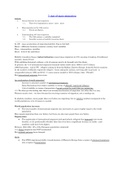7: Age of mass migration
Content:
1. General theories on mass migration
1.1. Three-level explanations: macro - meso - micro
2. Mass migration in the 19th century
2.1. Trends and figures
3. Understanding 19C mass migration
3.1. The 19th century = a mobility transition?
3.2. Scientific revision of mobility transition thesis
In 19C - mass acceleration of migration/mobility. Esp in 2nd half.
Macro - difference between countries: country level variables
Meso - intermediary variables
Micro - level of the individual
Mobility transition theses: industrialisation caused mass migration in C19, causing a breakup of traditional
societies. (main driver)
With unfolding historical evidence, a lot of nuances need to be brought into this thesis.
In general, the % of international migrants remained rather stable since 1960s to 2017 (/today).
1990 fluctuation - end of CW - refugees coming in from the Balkan, Eastern Europe, formerly Soviet countries.
In the number of officially registered refugees - those asking for asylum, not being able to go back - is
comparable between 1990 and 2015. => some nuance needed in ‘2015 refugee crisis’. (“floods”)
But international migrants have risen.
An acceleration of world migration?
- Increase in absolute number of international migrants.
- Some fluctuations but relative stability in terms of officially registered refugees.
- A lot of stability in terms of proportion of people across the world that are migrating.
==> We often get the feeling that there’s an increase/acceleration of migration, but often this is a very
Western-centric view. - we have become the receiving countries of migration, not a sending one.
In absolute numbers, more people than ever before are migrating, but in relative numbers (compared to the
world population), a lot of nuance is needed.
World population increase
● The total number of international migrants has increased at a pace roughly equal to the world
population.
More people migrating than ever before, but there are also more people than ever before.
Registration
● The registration of international migrants (and particularly refugees) has improved over recent
decades, so it’s questionable whether there has even been a significant increase in reality - past
numbers could have been higher.
Between 1846-1924: 12% of the European population emigrated.
==> Global migration has NOT accelerated.
But regional patterns have changed.
Shift
● Post WW2 migrational shifts: transformation of (Western) Europe from a region of colonisers/emigrants
into a region of immigration.
, This shift is a large contextual factor for fear towards refugees, newcomers and in general rhetoric about a
refugee crisis.
→ Relative stability at the level of global migration - has not accelerated.
→ What has changed dramatically is the country of destination.
The number of international migrants is very different across regions, especially high-, middle- and low-income
regions.
In absolute #s, high mobility for even lesser developed regions
Main differentiation is at the level of GDP and income between low-, middle- and high-income countries.
GDP, national income, height of wages, facilities and infrastructure connected to the welfare state, LC, level of
indn and post-indn, … }=> Multiple factors of development.
Also a lot of international migration within Europe itself.
- High-income countries have high immigrattion levels, not only because they’re attracting migrants
from poorer parts of the world, but also because of the integration of markets and a higher pattern of
migration between the rich countries themselves.
- Ex EU integration.
- International migrants accounted for a relatively small share of the world population (3.5% in 2019).
- Between 1990-2019, the # of international migrants as a share of the total population increased in more
developed and high income countries, but changed very little in less-developed countries and declined
in lower-income countries.
1. General theories on mass migration
1.1. Macro explanations for mass migration
Assumption: socio-economic and political inequalities are crucial for explaining migration.
Macro → deals with disparities/inequalities between countries. Focus on socio-economic and political
inequalities.
● Affect both the inception (start) of migration and its perpetuation.
- Socio-economic inequalities: rich vs poor countries & their level of attractiveness on a population.
- Political inequalities: respect for political freedoms, individual freedoms, religious tolerance, tolerance
towards sexualities, …
→ These are push and pull factors.
Based on a “push and pull” model of migration
● Focuses on the disparity in conditions between the place of origin and destination.
○ Push: induce people to leave their location (poverty, religious intolerance, political instability)
○ Pull: prompt people to move to a new location (democratic climate, job opportunities, religious
tolerance, booming economy)
○ Intervening obstacles: distance, knowledge, prior migration patterns, migration policies. (in
between push and pull factors)
■ Can you leave?
■ Migration policies: how open is the country towards newcomers?
Where do migrants in BE come from?
Italians are the largest foreign nationality group.
Fr, NL, Morocco, Spain, Turkey, DL (in decreasing order) ]- shows the effect of intervening obstacles.
- High numbers of people from Morocco and Italy, less from Turkey → explained by arrangements
between the Belgian government and Morocco and Italy after WW1: big employment schemes to get
foreign workers to work in the Belgian mining industry.
- As a result of these historical migration schemes with foreign countries, BE has a greater pull
today for Moroccans and Italians.




